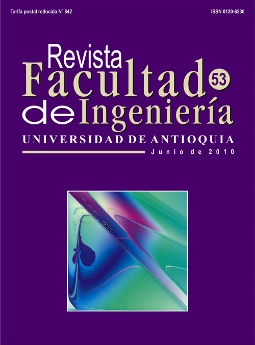Stiffness of chitosan in solution through intrinsic viscosity measurements
Keywords:
chitosan, stiffness, chain conformation, intrinsic viscosity, rheologyAbstract
Chitosan is the partially deacetylated derivative from chitin. It is very significant to understand the behavior of chitosan as a polyelectrolyte, since most of chitosan final applications are related with its aqueous solutions. In this research, hydrodynamic parameters are studied for samples of chitosan with different degree of acetylation (DA) and molecular weight, to gain insight into the behavior of this polymer at different concentrations and ionic strengths (I). To achieve this, chitosan with an initial molecular weight of 226 kD and 30% DA, was depolymerized and deacetylated to obtain different molecular weights and DA. Relative viscosities were measured by rotational rheometry to caculate the overlap concentration (C*) and the entanglement concentration (Ce). These two concentrations allowed us to establish the dilute and concentrated solution regimes. Intrinsic viscosity ([h]) was measured for each sample in acetic acid 0,3 M solution using four levels of I. These measurements were used to calculate the salt tolerance factor (S) and the stiffness parameter (B). [h] measurements were also used to estimate Mark-Howink-Kuhn-Sakurada a factor, and statistical parameters such as the persistence length, the Kuhn length and the radius of gyration. These results provide an approximation to the conformation and stiffness of chitosan chains. It was found that variations in DA do not cause conformational changes, but modifications of molecular weight can dramatically transform the stiffness of the chain. These results will be used for optimizing the preparation of biocompatible membranes.
Downloads
References
G. Berth, H. Dautzenberg. “The degree of acetylation of chitosans and its effect on the chain conformation in aqueous solution”. Carbohydrate Polymers. Vol. 47. 2002. pp. 39-51.
G. Berth, H. Dautzenberg, M. G. Peter. “Physico-chemical characterization of chitosans varying in degree of acetylation”. Carbohydrate Polymers. Vol. 36. 1998. pp. 205-216.
J. Brugnerotto, J. Desbrières, L. Heux, K. Mazeau, M. Rinaudo. “Overview on structural characterization of chitosan molecules in relation with their behavior in solution”. Macromolecular Symposia. Vol. 168. 2001. pp. 1-20.
M. Rinaudo, G. Pavlov, J. Desbrières. “Influence of acetic acid concentration on the solubilization of chitosan”. Polymer. Vol. 40. 1999. pp. 7029-7032.
S. Harding. “On the hydrodynamic analysis of macromolecular conformation”. Biophysical Chemistry. Vol. 55. 1995. pp. 69-93.
H. Cölfen, G. Berth, H. Dautzenberg. “Hydrodynamic studies on chitosans in aqueous solution”. Carbohydrate Polymers. Vol. 45. 2001. pp. 373-383.
A. V. Dobrynin, R. H. Colby, M. Rubinstein. “Scaling Theory of Polyelectrolyte Solutions”. Macromolecules. Vol. 28. 1995. pp. 1859-1871.
M. W. Anthonsen, K. M. Vårum, O. Smidsrød. “Solution properties of chitosans: conformation and chain stiffness of chitosans with different degrees of N-acetylation”. Carbohydrate Polymers. Vol. 22. 1993. pp. 193-201.
T. Odijk. “On the ionic-strength dependence of the intrinsic viscosity of DNA”. Biopolymers. Vol. 18. 1979. pp. 3111-3113.
J. Cho, M. C. Heuzey, A. Begin, P. J. Carreau. “Viscoelastic properties of chitosan solutions: Effect of concentration and ionic strength”. Journal of Food Engineering. Vol. 74. 2006. pp. 500-515.
J. Desbrières. “Viscosity of semiflexible chitosan solution: Influence of concentration, temperature, and role of intermolecular interactions”. Biomacromolecules. Vol. 3. 2002. pp. 342-349.
K. Mazeau, S. Pérez, M. Rinaudo. “Predicted influence of N-acetyl group content on the conformational extension of chitin and chitosan chains”. Journal of Carbohydrate Chemistry. Vol. 19. 2000. pp. 1269- 1284.
R. Signini, J. Desbrières, S.P. Campana Filho. “On the stiffness of chitosan hydrochloride in acid-free aqueous solutions”. Carbohydrate Polymers. Vol. 43. 2000. pp. 351-357.
S. E. Harding. “The intrinsic viscosity of biological macromolecules. Progress in measurement, interpretation and application to structure in dilute solution”. Progress in Biophysics and Molecular Biology. Vol. 68. 1997. pp. 207-262.
J. Brugnerotto, J. Desbrières, G. Roberts, M. Rinaudo. “Characterization of chitosan by steric exclusion chromatography”. Polymer. Vol. 42. 2001. pp. 9921- 9927.
S. Hokputsa, K. Jumel, C. Alexander, S. E. Harding. “Hydrodynamic characterisation of chemically degraded hyaluronic acid”. Carbohydrate Polymers. Vol. 52. 2003. pp. 111-117.
O. Smidsrød, A. Haug. “Estimation of the Relative Stiffness of the Molecular Chain in Polyelectrolytes from Measurements of Viscosity at Different Ionic Strengths”. Biopolymers. Vol. 10. 1971. pp. 1213- 1227.
X. Jiang, L. Chen, W. Zhong. “A new linear potentiometric titration method for the determination of deacetylation degree of chitosan”. Carbohydrate Polymers. Vol. 54. 2003. pp. 457-463.
G. G. Allan, M. Peyron. “Molecular weight manipulation of chitosan I: kinetics of depolymerization by nitrous acid”. Carbohydrate Research. Vol. 277. 1995. pp. 257-272
G. G. Allan, M. Peyron. “Molecular weight manipulation of chitosan II: prediction and control of extent of depolymerization by nitrous acid”. Carbohydrate Research. Vol. 277. 1995. pp. 273-282.
S. Nguyen, F. M. Winnik, M.D. Bushmann. “Improved reproducibility in the determination of the molecular weight of chitosan by analytical size exclusion chromatography”. Carbohydrate Polymers. Vol. 75. 2009. pp. 528-533.
Downloads
Published
How to Cite
Issue
Section
License
Copyright (c) 2018 Revista Facultad de Ingeniería

This work is licensed under a Creative Commons Attribution-NonCommercial-ShareAlike 4.0 International License.
Revista Facultad de Ingeniería, Universidad de Antioquia is licensed under the Creative Commons Attribution BY-NC-SA 4.0 license. https://creativecommons.org/licenses/by-nc-sa/4.0/deed.en
You are free to:
Share — copy and redistribute the material in any medium or format
Adapt — remix, transform, and build upon the material
Under the following terms:
Attribution — You must give appropriate credit, provide a link to the license, and indicate if changes were made. You may do so in any reasonable manner, but not in any way that suggests the licensor endorses you or your use.
NonCommercial — You may not use the material for commercial purposes.
ShareAlike — If you remix, transform, or build upon the material, you must distribute your contributions under the same license as the original.
The material published in the journal can be distributed, copied and exhibited by third parties if the respective credits are given to the journal. No commercial benefit can be obtained and derivative works must be under the same license terms as the original work.






 Twitter
Twitter